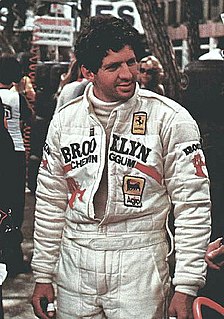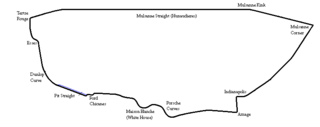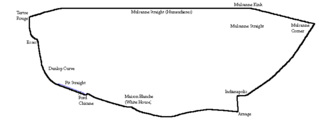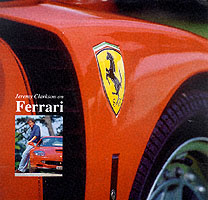Related Research Articles
Ignazio Giunti was an Italian racing driver. He competed in Formula One as well as in saloon and Sports Car Racing.

The 1979 Formula One season was the 33rd season of FIA Formula One motor racing. It featured the 1979 World Championship of F1 Drivers and the 1979 International Cup for F1 Constructors which were contested concurrently over a fifteen-round series which commenced on 21 January 1979, and ended on 7 October. The season also included three non-championship Formula One races. Jody Scheckter of Scuderia Ferrari won the 1979 World Championship of F1 Drivers while Scuderia Ferrari won 1979 International Cup for F1 Constructors. Gilles Villeneuve made it a 1–2 for Ferrari in the championship, concluding a successful second half of the 1970s for Ferrari. Alan Jones finished the season strongly for Williams, finishing third in the championship and with teammate Clay Regazzoni scoring Williams's first ever Grand Prix win as a constructor. Scheckter's title was Ferrari's last drivers' title for 21 years, before Michael Schumacher won five consecutive titles for the team between 2000 and 2004.

Arturo Francesco "Art" Merzario is a racing driver from Italy. He participated in 85 Formula One World Championship Grands Prix, debuting on 15 July 1972. He scored 11 championship points.

Bizzarrini S.p.A. was an Italian automotive manufacturer in the 1960s founded by former Alfa Romeo, Ferrari and Iso engineer Giotto Bizzarrini. The company built a small number of highly developed and advanced sport and racing automobiles before failing in 1969. Notable models include the 5300 GT Strada and the P538S.
The Ferrari P was a series of Italian sports prototype racing cars produced by Ferrari during the 1960s and early 1970s.

The Auto Avio Costruzioni 815 was the first car to be fully designed and built by Enzo Ferrari. Legal issues with former associates Alfa Romeo prevented Ferrari from creating the Ferrari marque. The 815 raced at the 1940 Brescia Grand Prix, where both entries failed to finish due to engine problems. One of the cars was later scrapped, while the other is currently in a car collection in Italy.
Ferrari is an Italian company which has produced sports cars since 1947, but traces its roots back to 1929 when Enzo Ferrari formed the Scuderia Ferrari racing team.

Ferrari 512 S is the designation for 25 sports cars built in 1969–70, with five-litre 12-cylinder ("512") engines, related to the Ferrari P sports prototypes. The V12-powered cars were entered in the 1970 International Championship for Makes by the factory Scuderia Ferrari and private teams. Later that year, modified versions resembling their main competitor, the Porsche 917, were called Ferrari 512 M. In the 1971 International Championship for Makes, the factory focused on the new Ferrari 312 PB and abandoned the 512 which was only entered by privateers. From 1972 onwards, the 512 was withdrawn from the world championship following a change in the regulations, and some 512s in private hands were entered in CanAm and Interserie races.

The Ferrari 312 F1 was the designation of the 3 litre V-12 Formula One cars raced by the Italian team from 1966 to 1969. Designed under the leadership of Mauro Forghieri, there were two distinct variations using this designation, the 1966 version and the completely different 1967-69 version. The '66 cars carried on the chassis numbering sequence from the previous year's 1.5 litre cars, while the '67 cars began a new sequence at "0001". To avoid confusion, the cars are commonly referred to as 312 F1-66, 312 F1-67 etc.

The 1974 24 Hours of Le Mans was the 42nd Grand Prix of Endurance, and took place on 15 and 16 June 1974. It was the fifth round of the 1974 World Championship for Makes. After Alfa Romeo had won the first race of the season at Monza, it had been Matra all the way and they came to Le Mans as firm favourites for a third consecutive outright victory, especially after Alfa Romeo withdrew its cars just before raceweek.

The 1973 24 Hours of Le Mans was the 41st Grand Prix of Endurance and took place on 9 and 10 June 1973. It was the eighth round of the 1973 World Championship of Makes.

The 1970 24 Hours of Le Mans was the 38th Grand Prix of Endurance and took place on 13 and 14 June 1970. It was the eighth round of the 1970 World Sportscar Championship season.

The Ferrari 312T was a Ferrari Formula One car design, based on the 312B3 from 1974. In various versions, it was used from 1975 until 1980. It was designed by Mauro Forghieri for the 1975 season and was an uncomplicated and clean design that responded to mechanical upgrades.

Mauro Forghieri is an Italian mechanical engineer, best known for his work as a Formula One racing car designer with Scuderia Ferrari during the 1960s and 1970s. He is credited for introducing the first designed rear wings to Formula One at the 1968 Belgian Grand Prix, and designing the first transversal automatic gear, also known as T gear.

The Ferrari 312 PB was a Group 6 Prototype-Sports Car introduced in 1971 by Italian carmaker Ferrari. It was officially designated the 312 P, but often known as the 312 PB to avoid confusion with a previous car of the same name. It was part of the Ferrari P series of Prototype-Sports Cars but was redesignated as a Group 5 Sports Car for 1972.

The Ferrari 312 P was a Group 6 Prototype-Sports Car used for racing in 1969 and 1970. The new 1971 version of the sports prototype came with a flat-12 engine, often referred to as a boxer engine. Many publications added the letter B after the P of its name to indicate its engine type, but this variation was never officially sanctioned by Ferrari which simply called it the 1971 312P.

The Ferrari 312B is a Formula One racing car designed and built by Scuderia Ferrari. It was the successor to the Ferrari 312 and was used from 1970 until early 1975. The original 312B was developed into the 312B2 and 312B3.

The Ferrari 641 was the Formula One racing car with which the Ferrari team competed in the 1990 Formula One World Championship. Driven by Alain Prost and Nigel Mansell, it won six Grands Prix.

Jeremy Clarkson on Ferrari is a nonfiction book, published in 2000, written by British journalist and television presenter Jeremy Clarkson. The book covered every model made by Ferrari up to the Ferrari 360 Modena accompanied by colour photographs.

The Ferrari 412 S was a unique sports racing car produced by Ferrari in 1958. The 412 S combined Ferrari's most powerful V12 engine to date with a one-off experimental racing chassis. It was also incorrectly called as the 412 MI due to being built around an engine from the 500 Miles of Monza racer. The car was created specifically for John von Neumann to take on the American racing cars Scarabs in SCCA racing. Its famed drivers included Phil Hill and Richie Ginther.
References
- ↑ "Miniature race cars". mps-sportproto.com.
- ↑ "Fine Art Models presents Pierre Scerri". web.archive.org. February 1, 2003.